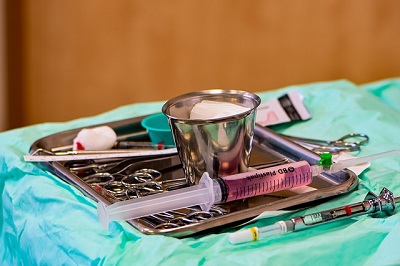Can Hydrosalpinx Be Thoroughly Drained by Aspiration Surgery?
The fallopian tubes are crucial in the female reproductive system, acting as a vital passageway that transports eggs to meet sperm and achieve fertilization. However, if the fallopian tubes develop inflammation or other issues, fluid may accumulate in the tube, leading to hydrosalpinx.

This accumulated fluid is no trivial matter. It disrupts the regular transport of eggs and hinders the mixing of sperm and eggs, significantly reducing the chances of conception.
In the long journey of seeking to conceive, many women encounter various difficulties and troubles, and hydrosalpinx is one of the significant issues that should not be underestimated.
For women who eagerly hope to have a baby, any treatment method brings with it a mixture of hope and anxiety. As a potentially effective treatment method, aspiration surgery raises numerous questions: Can it completely resolve or solve the hydrosalpinx issue? Completion surgery involves guiding a fine needle into the hydrosalpinx using ultrasound or similar imaging technology to draw out the accumulated fluid.
This may sound simple, but in reality, it requires a high level of skill and experience from the doctor. The doctor must accurately locate the fluid accumulation and perform the procedure with extreme care to avoid damaging the surrounding tissues.
In reality, this depends on several factors.
First, the severity of the hydrosalpinx. When the fluid accumulation is minimal and concentrated, aspiration surgery usually yields good results. Conversely, if a large amount of fluid is spread over a wide area, more than a single aspiration may be required to remove all the fluid.
Second, the structure and functional condition of the fallopian tubes. If the fallopian tubes have severe adhesions, damage, or deformities, successful fluid aspiration may not lead to functional recovery. For instance, Mrs. Cooper, despite undergoing aspiration surgery and having most of the fluid removed, still faced significant challenges in conceiving due to structural damage to her fallopian tubes.
Additionally, the patient's health condition. Some patients may have immune system issues that make them prone to infections or recurrent inflammation after the surgery, affecting the effectiveness of fluid removal and the recovery of fallopian tube function.
Furthermore, the precision of the surgical procedure and the doctor's experience. Skilled doctors can more accurately locate the fluid accumulation and perform the aspiration with appropriate techniques, increasing the success rate of complete fluid removal.
Lastly, postoperative care and rehabilitation measures. Suppose the patient needs to strictly follow medical advice, such as engaging in strenuous activities too soon or neglecting personal hygiene. In that case, it may lead to reformation of fluid accumulation or poor surgical outcomes.
If the patient has coagulation disorders or a tendency to bleed, aspiration surgery for hydrosalpinx is not recommended due to the risk of severe complications. Besides aspiration surgery, other methods exist to treat hydrosalpinx, such as salpingostomy and tubal ligation. Each method has its advantages, disadvantages, and applicable ranges.
When choosing a treatment method, patients must communicate thoroughly with their doctors and make the most appropriate choice based on their conditions.
This chronic condition cannot be cured by aspiration alone. It is recommended that females take the Fuyan Pill, which has over thirty years of treatment experience and can alleviate tubal obstruction caused by hydrosalpinx. Additionally, the pill can clear heat and dampness, detoxify, and reduce inflammation, effectively addressing the root cause of hydrosalpinx.
In summary, whether hydrosalpinx can be thoroughly drained by aspiration surgery cannot be generalized. Various factors influence it and require a comprehensive consideration of the patient's condition. For women undergoing aspiration treatment, it is important to rest after the surgery and avoid strenuous activities.
Additionally, personal hygiene should be maintained, such as keeping the vulva clean and dry and frequently changing underwear.
You may also be interested in:
Why is Laparoscopy Not Recommended for Hydrosalpinx?
Does Hydrosalpinx Significantly Affect Pregnancy?
What Are Other Methods to Treat Hydrosalpinx Besides Surgery?
Scientific Protection of Blockage: 3 Tips Women Need to Know
previous pageWhich is More Severe: Fallopian Tube Blockage or Adhesions?
next page- Hydrosalpinx and IVF: What Are the Chances of Successful Embryo Implantation?
- Is Hysterosalpingography Harmful to the Body?
- Can Hydrosalpinx Be Thoroughly Drained by Aspiration Surgery?
- Pay Special Attention to These Hydrosalpinx Symptoms!
- Hydrosalpinx: Frequent Checks and Excessive Anxiety Affect Pregnancy!
Testimonials
- Adenomyosis with Ureaplasma Urealyticum Cured by Fuyan Pill
- Tubal blockage with hydrosalpinx can be cured by TCM shortly
- Fuyan Pill Helps A woman with Adenomyosis Get Pregnant
- A Woman with Hydrosalpinx Is Cured with Fuyan pill
- Pelvic Inflammatory Disease Testimonials
- Irregular Vaginal Bleeding and Endometrial Thickening Cured by Fuyan Pill
- Pruritus Vulvae and Frequent Urination: Mycoplasma Infection Cured after 2 Courses



